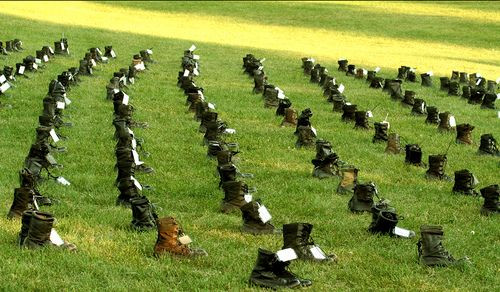Iraq War Deaths Now Estimated At 461,000: For Every 3 Killed By Violence, 2 Died From Iraq’s Failing Infrastructure

The devastating effects of the Iraq war are still being felt in pockets of the battle-beaten country, as researchers surveying the region now estimate the death toll has climbed to nearly half a million people. But faceless violence doesn’t tell the whole story: for every three deaths attributable to violence, two people die because of Iraq’s crumbling health care systems, water supply, and sustainable nutrition sources.
Researchers from Johns Hopkins University, Simon Fraser University, Mustansiriya University, and the University of Washington's Institute for Health Metrics and Evaluation conducted a broad sweep of nearly 2,000 randomly selected households in Iraq, covering more than 100 clusters throughout the country. Their representative findings pegged the total death toll at 461,000 people, although the true number could be as low as 48,000 and as high as 751,000, they argue. The range may seem vast, but for comparison’s sake, three years after a massive earthquake struck Haiti in 2010, experts have put the death toll between 46,000 and 316,000.
"Policymakers, governments and the public need better data on the health effects of armed conflict," Amy Hagopian, associate professor of Global Health at the University of Washington and the lead author of the study, said in a news release. "Without this information, it's impossible to assess the true human costs of war."
As expected, violent deaths comprised the majority of the overall total, approximately 60 percent. Based on household survey responses, gunshots reportedly caused 62 percent of violent deaths; car bombs, 12 percent; and other explosions, nine percent.
The rest of the deaths were caused by indirect factors, such as untreated diseases, famine, or unclean water supplies. Forty-seven percent of non-violent deaths were the result of cardiovascular conditions, while other reasons filled out the rest: infant or childhood deaths, 12.4 percent; chronic illness, 11 percent; and cancer, eight percent.
Researchers first analyzed death rates before the war, prior to conducting their post-war survey. As a follow-up to their preliminary data, they asked individual households if they had experienced any births or deaths since 2001. They also questioned each adult in the households whether a sibling had died in the same time period. In addition to the 405,000 excess Iraqi deaths recorded through mid-2011, the team also found emigrants comprised 55,805 deaths — a conservative estimate, the researchers claim.
Before the war, deaths occurred at half the rate compared to after the war had begun. The rates continued to rise until 2003, then plateaued until 2006, where they reached a new peak. From there, deaths dropped until 2008, leveling off until 2011, where they rose again slightly.
Hagopian said the analysis takes into account the nearly two million people who fled the country as a result of the war’s devastation.
Measuring the overall death rates can be slippery, she added, primarily because the methodology for collecting data must be completely precise. Tracking human deaths over a long period of time requires accurate knowledge from each household and a consistent procedure for obtaining data.
Gilbert Burnham, professor and co-director of the Refugee and Disaster Response at Johns Hopkins, said the team’s compulsion to carry out the study stemmed from this need.
"There were two big reasons to do this study: to cover the entire period of the war and to improve on the groundwork laid by earlier studies," he said. "By broadening the sources of information we used and by covering the full length of the conflict, this study provides a more complete picture of mortality during the Iraq war."
Published by Medicaldaily.com



























